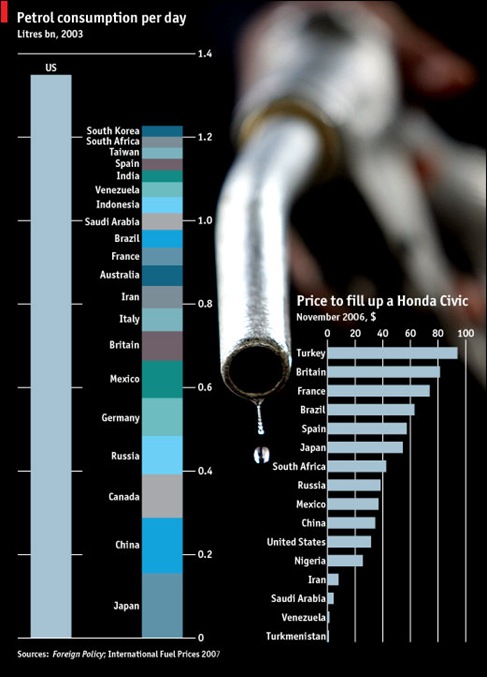Gushing Irony
On Monday, police in Istanbul dispersed a band of protesters at an international forum on water shortage—by blasting them with water cannons.
The meetings involved policymakers, scientists, and activists from more than 120 countries.
Reuters reports:
Turkish police, who on Monday fired water canons and tear gas to disperse protesters gathered at the start of the forum, told state-run Anatolian they prefer to use water because it is cheaper than tear gas.
Police officials said they normally use 13 to 14 tonnes (13-14 cubic metres) of water to disperse a crowd at a cost of 400 lira ($235). In similar circumstances, police have to use around 500 teargas bombs at a cost of 12,500 lira ($7,350), they said.

This is what a water cannon looks like.
The ‘Thirsty ’30s?’
Speaking to the United Kingdom’s 2009 Sustainable Development conference, top government scientist John Beddington projects that by 2030 the world as a whole will face critical shortages in food, water, and energy beyond anything yet experienced on a large scale.
According to Professor Beddington, the world of 2030 will be populated by about 8.3 billion people. Demand for food and energy will have increased by 50%, and fresh water demand will have jumped up 30%.
BBC News reports:
Prof Beddington said the concern now – when prices have dropped once again – was that the issues would slip back down the domestic and international agenda.
“We can’t afford to be complacent. Just because the high prices have dropped doesn’t mean we can relax,” he said.
Improving agricultural productivity globally was one way to tackle the problem, he added.
At present, 30-40% of all crops are lost due to pest and disease before they are harvested.
Professor Beddington said: “We have to address that. We need more disease-resistant and pest-resistant plants and better practices, better harvesting procedures.
“Genetically-modified food could also be part of the solution. We need plants that are resistant to drought and salinity – a mixture of genetic modification and conventional plant breeding.
Better water storage and cleaner energy supplies are also essential, he added.
Prof Beddington is chairing a subgroup of a new Cabinet Office task force set up to tackle food security.
While unstable geopolitics, environmental issues such as climate change and pollution, and financial mayhem all clamor for the attention of today’s busy technocrat, some scientists point out that this simple, potent mixture of rising demand for resources and an aggressively booming population is perhaps the biggest problem our global society has currently to address.
‘Endgame’ in Iraq? And what game would that be, exactly?

U.S. Defense Secy. Robert Gates
BBC News reports that U.S. Defense Secretary Robert Gates, slated to keep his post after Obama takes office in January, has told U.S. troops on an airbase in Iraq that their mission is in its ‘endgame’:
Mr Gates said the US military presence would undergo a “significant change of mission” next June when troops are due to withdraw from Iraq’s urban areas.
Under a recently agreed deal between the two countries, US troops will completely withdraw from Iraq by 2011.
However, the US general leading US troops in Iraq has said he expects some soldiers to stay in cities beyond June.
The Iraqi parliament voted in favour of the new security deal with the Americans last month. Iraq’s government has hailed the agreement as the prelude to the return of full sovereignty to the country.
Not that this is the first time we’ve heard such talk, of course. But this time, Pentagon officials may actually be speaking from their icy black hearts.
Commanders on the ground in Iraq expect to restore native control to all 18 Iraqi provinces by June, under the terms of a new security deal with the government of Prime Minister Maliki. U.S. voters will expect incoming president Barack Obama to deliver on his promises of a deliberate but expeditious withdrawal from Iraq.
But it isn’t all campaign politics; the simple truth is that, while automakers badger the U.S. Congress for a handout of a few billion dollars, the staggering financial costs of the occupation of Iraq—in the hundreds of billions per annum—continue to create debt and leave federal and industrial resources ever more tightly stretched. The presence of 150,000 troops in Iraq is edging towards the logistically untenable, and recent developments have created an environment in which withdrawal on Washington’s terms is becoming more opportune.
In October, the Iraqi government officially opened its oil reserves—the third-largest proven reserves in the world—to dozens of foreign investors, under the terms of an ownership contract which was never made public. Crude oil prices have recently plummeted in the wake of decreased demand, but with the hands of international oil companies on the spickets in the petroleum paradise of southern Iraq, OPEC is now largely unable to effectively counter in many markets. Critics of the U.S. administration have long maintained that gaining the ability to exert this kind of pressure on oil markets, from the Middle East to Venezuela, has always been a primary goal of the occupation of Iraq.
 Another important prerequisite for withdrawal which is now a fait accompli is the establishment of a series of ‘megabases’ throughout Iraq, including some of the largest such facilities anywhere on the globe. TomDispatch reports:
Another important prerequisite for withdrawal which is now a fait accompli is the establishment of a series of ‘megabases’ throughout Iraq, including some of the largest such facilities anywhere on the globe. TomDispatch reports:
By now, billions have evidently gone into single massive mega-bases like the U.S. air base at Balad, about 60 miles north of Baghdad. It’s a “16-square-mile fortress,” housing perhaps 40,000 U.S. troops, contractors, special ops types, and Defense Department employees. As the Washington Post’s Tom Ricks, who visited Balad back in 2006, pointed out — in a rare piece on one of our mega-bases — it’s essentially “a small American town smack in the middle of the most hostile part of Iraq.” Back then, air traffic at the base was already being compared to Chicago’s O’Hare International or London’s Heathrow — and keep in mind that Balad has been steadily upgraded ever since to support an “air surge” that, unlike the President’s 2007 “surge” of 30,000 ground troops, has yet to end. . .
. . .Think of this as the greatest American story of these years never told — or more accurately, since there have been a few reports on a couple of these mega-bases — never shown. After all, what an epic of construction this has been, as the Pentagon built a series of fortified American towns, each some 15 to 20 miles around, with many of the amenities of home, including big name fast-food franchises, PXes, and the like, in a hostile land in the midst of war and occupation. In terms of troops, the President may only have put his “surge” strategy into play in January 2007, but his Pentagon has been “surging” on base construction since April 2003.
Aside from providing a bottomless boon to salivating contractors, these airbases ensure that, even with the vast majority of manpower extracted from the region, the U.S. can continue to project its power into the Middle East to protect its diplomatic and economic interests. This sends a strong message to the re-emerging Russian Federation as well as to regional powers such as Iran.
So while it may be true that the official U.S. mission in Iraq is coming to a close, in the sense of realpolitik, the ‘game’ may be just beginning.
The climate changes, but not much else
While European leaders congratulate themselves at the close of a two-day Brussels summit on climate change, their numerous critics are left shaking their heads in dismay.
An agreement was reached whereby EU nations will be required, by 2020, to cut greenhouse gas emissions by 20% as compared to 1990 levels. Additionally, the pact calls for a 19% reduction in CO2 emissions from automobiles by 2015, and for measures to increase the use of renewable energy and to improve on overall fuel efficiency in the coming years. Also laid out was a carbon emissions trading scheme, perhaps the most comprehensive of its kind yet put into place in the world economy.
The Guardian reports that the product of the talks represents a major victory for French President Nicolas Sarkozy, as he nears the end of his six-month tenure as President of the EU. The European Parliament is set to write the decisions into law next week.
“This is a major advance,” said [UK] prime minister, Gordon Brown. “Europe after these decisions remains the leader on climate change.”
But critics complained that the package was too little too late, that EU leaders had capitulated to fierce lobbying from European industry, that the loopholes in the system and the awarding of pollution permits free to most non-energy firms in the scheme would trigger a bonanza in windfall corporate profits.
“Industry has to do next to nothing,” said Claude Turmes, a leading Green MEP from Luxembourg, who helped to draft part of the legislation. “If they are honest, these leaders know they haven’t agreed something really ambitious.”
“This could have been one of Europe’s finest moments,” said Robin Webster, climate campaigner for Friends of the Earth. “But huge loopholes allow big energy-users to carry on polluting.”
Barroso admitted that the terms of the deal could bring windfall profits for industry, reversing the logic of the polluter pays principle that is supposed to underpin the carbon trading scheme.
In particular, critics feel the accords go incredibly soft on certain industries, such as coal processors—which, although among the very worst emissions offenders, will be given generous discounts in the carbon trading arena—and steel refineries. Industries such as these will hardly flinch in the wake of this “major advance.”
According to the New York Times, President-Elect Barack Obama has placed confronting climate change second only to the revitalization of the U.S. economy on his to-do list, and in its acknowledgement of the issues at hand, his administration is sure to represent a marked improvement over the Bush years. Indeed, on Tuesday Obama met privately with 2007 Nobel Prize winner Al Gore to discuss climate change and energy policy, though the Obama camp denies a potential role for Gore in the new White House. But environmentalists are skeptical as to just how far the impassioned rhetoric will carry over into reality come January; if European leaders consider the kind of agreement just reached in Brussels to be a colossal step forward, one wonders if substantiation of the change Obama has in mind is bound to prove commensurately disappointing. Obama’s plans are ambitious, but his ability to enforce them remains unproven.
Political leaders tend to shy away from forcing stringent environmental standards on industry because such measures can have significant front-end overhead and can make certain products at least initially unpalatable to consumers. This wariness is only amplified in times of economic crisis. Americans can expect the new President to be far more forthright and engaging on environmental policy than his predecessor, but should not harbor illusions. Lobbyists are still lobbyists, capitalism is still capitalism, and automobiles still run—mostly—on gasoline.
In a hole in the ground there lived an eco-warrior.
 A UK man, his dad, and some friends and passersby have built, for around US$5,000, an ultra-low impact family home in Wales. They say you can do it, too.
A UK man, his dad, and some friends and passersby have built, for around US$5,000, an ultra-low impact family home in Wales. They say you can do it, too.
Simon Dale and his wife work in the surrounding terrain doing forest management, something Dale says wouldn’t be possible if they had to mortgage a brick home somewhere. Using mainly a chainsaw and a hammer, taking their timber from fallen trees in the environs, and garnering everything from plumbing and wiring to windows from piles of discarded junk, Dale—a self-described first-time architect—has exhibited amazing resourcefulness in creating an ecologically responsible and downright cozy-looking abode.
Why has Dale done this?
Our society is almost entirely dependent on the availability of increasing amounts of fossil fuel energy. This has brought us to the point at which our supplies are dwindling and our planet is in ecological catastrophe. We have no viable alternative energy source and no choice but to reduce our energy consumption. The sooner this change can be begun, the more comfortable it will be.
For our energy consumption to decrease we must reduce consumption and dramatically increase the productivity of our land. This will require developing infrastructure and skills to enable locally self-reliant living. The simplest, sustainable solutions involve small-scale permaculture type land management systems centred around individual or small groups of dwellings. There is significant and growing energy at the grass-roots to start implementing these low impact developments. This enthusiasm comes from a combination of intellectual concern and the innate appeal of living closer to nature. The major obstacle is access to land. The price of land with residential planning permission is not commensurate with the income from this type of living. This will change, but these projects need time to develop and reach productivity. A few people are taking direct action but the numbers are far short of the critical mass that could be realised. If allowances can be made within the planning system to grant access to land, and the right to live on it, to those wishing to live this life, we can allow a grass-roots tide of people to make real progress towards a sustainable society.
The house uses a few solar panels to provide enough electricity for night light and computing. Water comes by gravity from a nearby spring, and heat is provided through a fireplace specially designed to capture and radiate the maximum amount of thermal energy.
CSTF salutes Mr. Dale and wishes him all the best. If there were more of him in the world, it’d be a happier planet.

“Daddy, Why Are There Wars?”
“Because some people are just plain evil, m’boy! Just plain evil.” Yuk, yuk; yeah, we know. That’s it. It’s Luke Skywalker and Darth Vader, all the time.
Try economics.
Sometimes, nothing obviates further elucidation of the already disturbingly apparent like a good infographic. From Foreign Policy magazine, for instance, via this site, is a columnar graph illustrating the daily consumption of oil in the United States and in various other countries of the world, and another graph showing average fill-up prices in various countries:

Austin, TX to Require Zero-Energy Homes by 2015
Jetson Green writes on an Austin, Texas city initiative that will ramp up energy efficiency standards through 2015. The big surprise? It may actually save money in the long run:
The City of Austin, after a year of serious research by the Zero Energy Capable Homes Task Force, announced a huge initiative towards requiring all new single-family homes to be zero-energy capably by 2015. Here’s how it works. Today, the city adopted the first in a series of code amendments and a road map of code amendments that will be implemented through 2015. Due to this first series of changes, roughly 6500 new homes built in Austin will be about 20% more efficient. Through 2015, as the code changes ratchet up the efficiency baseline, homes will end up using about 65% less energy than those built today. Then, owners will have the option of adding solar or some other clean tech to get the home to zero energy status.
Speaking of the Zero Energy Homes Initiative, Mayor Will Wynn said, “We’re taking action today that will lower the cost of utility bills, make housing more affordable, help improve air quality and take critical steps in the fight against global warming.“
I’m always a bit startled by the phrase “fight against global warming.” I suppose it is more politically neutral than the “fight against industrial excess.”













leave a comment